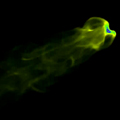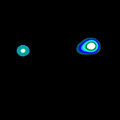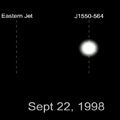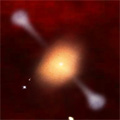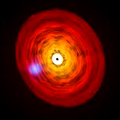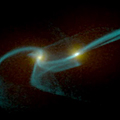CXC Home | Search | Help | Image Use Policy | Latest Images | Privacy | Accessibility | Glossary | Q&A
1. Simulation of Jet Evolution
QuicktimeMPEG Broadcast:
This simulation illustrates the evolution of a magnetized jet of high-energy particles as it moves at near the speed of light through a low-density gas. Scientists believe that the western jet in XTE J1550-564 developed its cometary shape by a similar process.
[Runtime: 0:07]
(I.Tregillis (Univ. of Minnesota/LANL), T.Jones (Univ. of Minnesota), D.Ryu (Chungnam National Univ.y, South Korea))
Related Chandra Images:
QuicktimeMPEG Broadcast:
- QuickTime movie (uncompressed)
- D1 (0.9 pixel aspect ratio)
- 720x486
- 29.97 fps
- file size = (1.7 MB)
This simulation illustrates the evolution of a magnetized jet of high-energy particles as it moves at near the speed of light through a low-density gas. Scientists believe that the western jet in XTE J1550-564 developed its cometary shape by a similar process.
[Runtime: 0:07]
(I.Tregillis (Univ. of Minnesota/LANL), T.Jones (Univ. of Minnesota), D.Ryu (Chungnam National Univ.y, South Korea))
Related Chandra Images:
- Photo Album: XTE J1550-564
2. Time-lapse Movie of Chandra Images (unlabeled)
QuicktimeMPEG Broadcast:
This time-lapse movie made from observations over a four-year period shows the black hole XTE J1550-564 (center), the approaching eastern jet, and the receding western jet (right). In four years the jets moved about two light years from the black hole.
[Runtime: 0:15]
(NASA/CXC)
Related Chandra Images:
QuicktimeMPEG Broadcast:
- QuickTime movie (uncompressed)
- D1 (0.9 pixel aspect ratio)
- 720x486
- 29.97 fps
- file size = (3.2 MB)
This time-lapse movie made from observations over a four-year period shows the black hole XTE J1550-564 (center), the approaching eastern jet, and the receding western jet (right). In four years the jets moved about two light years from the black hole.
[Runtime: 0:15]
(NASA/CXC)
Related Chandra Images:
- Photo Album: XTE J1550-564
3. Time-lapse Movie of Chandra Images (labeled)
QuicktimeMPEG Broadcast:
This time-lapse movie made from observations over a four-year period shows the black hole XTE J1550-564 (center), the approaching eastern jet, and the receding western jet (right). In four years the jets moved about two light years from the black hole.
[Runtime: 0:53]
(NASA/CXC)
Related Chandra Images:
QuicktimeMPEG Broadcast:
- QuickTime movie (uncompressed)
- D1 (0.9 pixel aspect ratio)
- 720x486
- 29.97 fps
- file size = (6.7 MB)
This time-lapse movie made from observations over a four-year period shows the black hole XTE J1550-564 (center), the approaching eastern jet, and the receding western jet (right). In four years the jets moved about two light years from the black hole.
[Runtime: 0:53]
(NASA/CXC)
Related Chandra Images:
- Photo Album: XTE J1550-564
4. Animation of How Supermassive Black Holes Affect the Formation of Massive Galaxies
QuicktimeMPEG Broadcast:
This animation begins by looking at the exterior of an elliptical galaxy. It then zooms into the region near the galaxy's massive central black hole. The sequence then shows how powerful jets of high-energy particles emanate from the vicinity of the black hole. These jets heat gas around the galaxy and stop the infall of matter into the galaxy, thereby limiting the galaxy's growth. This is what astronomers believe is happening in the cases of 4C41.17 and 3C294.
[Runtime: 0:22]
View Stills
(NASA/CXC/A.Hobart)
Related Chandra Images:
QuicktimeMPEG Broadcast:
- QuickTime movie (uncompressed)
- D1 (0.9 pixel aspect ratio)
- 720x486
- 29.97 fps
- file size = (171.1 MB)
This animation begins by looking at the exterior of an elliptical galaxy. It then zooms into the region near the galaxy's massive central black hole. The sequence then shows how powerful jets of high-energy particles emanate from the vicinity of the black hole. These jets heat gas around the galaxy and stop the infall of matter into the galaxy, thereby limiting the galaxy's growth. This is what astronomers believe is happening in the cases of 4C41.17 and 3C294.
[Runtime: 0:22]
View Stills
(NASA/CXC/A.Hobart)
Related Chandra Images:
- Photo Album: 4C41.17
5. Animation of an X-ray Binary System
QuicktimeMPEG Broadcast:
This animation begins with a view outside of Milky Way and then zooms in on one of the spiral arms to the double-star system XTE J1550-564, which contains a black hole and a normal Sun-like star. As gaseous material is pulled off the companion star onto the black hole, it forms a disk that is heated to millions of degrees. The animation then shows the ejection and evolution of the jets of high-energy particles.
[Runtime: 1:06]
(NASA/CXC/A.Hobart)
Related Chandra Images:
QuicktimeMPEG Broadcast:
- QuickTime movie (uncompressed)
- D1 (0.9 pixel aspect ratio)
- 720x486
- 29.97 fps
- file size = (311.4 MB)
This animation begins with a view outside of Milky Way and then zooms in on one of the spiral arms to the double-star system XTE J1550-564, which contains a black hole and a normal Sun-like star. As gaseous material is pulled off the companion star onto the black hole, it forms a disk that is heated to millions of degrees. The animation then shows the ejection and evolution of the jets of high-energy particles.
[Runtime: 1:06]
(NASA/CXC/A.Hobart)
Related Chandra Images:
- Photo Album: XTE J1550-564
6. Galaxy Merger Simulation and Chandra Data
QuicktimeMPEG This sequence begins with a data simulation of two galaxies that are about to merge. The simulation then stops and fades into the highest-energy (5-8 keV) X-ray data of NGC 6240. These two distinct point sources in the Chandra data are proof to scientists that two black holes at the center of this galaxy.
[Runtime: 0:15]
(Simulation: Josh Barnes (U of Hawaii)/John Hibbard (NRAO); X-ray: NASA/CXC/MPE/S.Komossa et al.)
Related Chandra Images:
QuicktimeMPEG This sequence begins with a data simulation of two galaxies that are about to merge. The simulation then stops and fades into the highest-energy (5-8 keV) X-ray data of NGC 6240. These two distinct point sources in the Chandra data are proof to scientists that two black holes at the center of this galaxy.
[Runtime: 0:15]
(Simulation: Josh Barnes (U of Hawaii)/John Hibbard (NRAO); X-ray: NASA/CXC/MPE/S.Komossa et al.)
Related Chandra Images:
- Photo Album: NGC 6240


